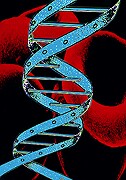
THURSDAY, June 3 (HealthDay News) — A new and complex genetic analysis has revealed that Jews all over the world are related by virtue of uniquely shared genetic traits dating back several millennia.
Down the line, the finding has the potential to aid in broader investigations on the genetic origins of disease, according to researchers from the Albert Einstein College of Medicine of Yeshiva University and New York University School of Medicine.
“This study provides new genomic information that can benefit not only those of Jewish ancestry, but the population at large,” co-author Dr. Edward Burns, executive dean and professor of pathology and medicine at the Albert Einstein College of Medicine, said in a news release. “By providing a comprehensive genetic fingerprint of various Jewish subpopulations, it can help us understand genetic links to heart disease, cancer, diabetes and other common diseases.”
Burns and his colleagues present these observations in the June 3 online issue of the American Journal of Human Genetics.
To explore the subject, the authors recruited 237 patients from Jewish communities in New York, Seattle, Athens, Rome and Israel. The participants were carefully selected to represent all three groups of the “Jewish Diasporas,” the historical migration of Jews throughout Europe and the Middle East. These groups included Eastern European Ashkenazim; Italian, Greek, and Turkish Sephardim; and Iranian, Iraqi, and Syrian Mizrahim Jews.
To ensure proper representation, Burns and his team only included individuals whose four grandparents all came from the same Jewish community. In turn, the genetic analysis of the Jewish participants was compared with that of 418 non-Jewish men and women, also drawn from communities around the world.
The authors found that not only did the Jewish group as a whole constitute a distinct population cluster, but that one by one each of the three Diaspora subgroups themselves also represented a distinct cluster within the larger Jewish group. They further noted that the two largest subgroups — Middle Eastern Jews and European Jews — were found to have split off from one another about 2,500 years back.
The team noted while the genetic pool of Jew is distinct, it is closely related to the non-Jewish populations of both Europe and the Middle East. In addition, each of the Jewish subgroups was linked to a Middle Eastern ancestry, and represented a degree of mixing with the non-Jewish population in which each group had lived.
“The study supports the idea of a Jewish people linked by a shared genetic history,” Dr. Harry Ostrer, an NYU professor of pediatrics, pathology and medicine, stated in the news release. “Yet the [mixture] with European people explains why so many European and Syrian Jews have blue eyes and blond hair.”
“The goal of the study was to determine a genomic baseline,” lead author Gil Atzmon, an Einstein assistant professor of medicine and of genetics, said in the news release. “With this established, we’ll be able to more easily identify genes associated with complex disorders like diabetes that are determined by multiple variants across the genome. Armed with this information, we will be better positioned to treat patients.”
More information
For more on genetic mapping, visit the U.S. National Institutes of Health.

